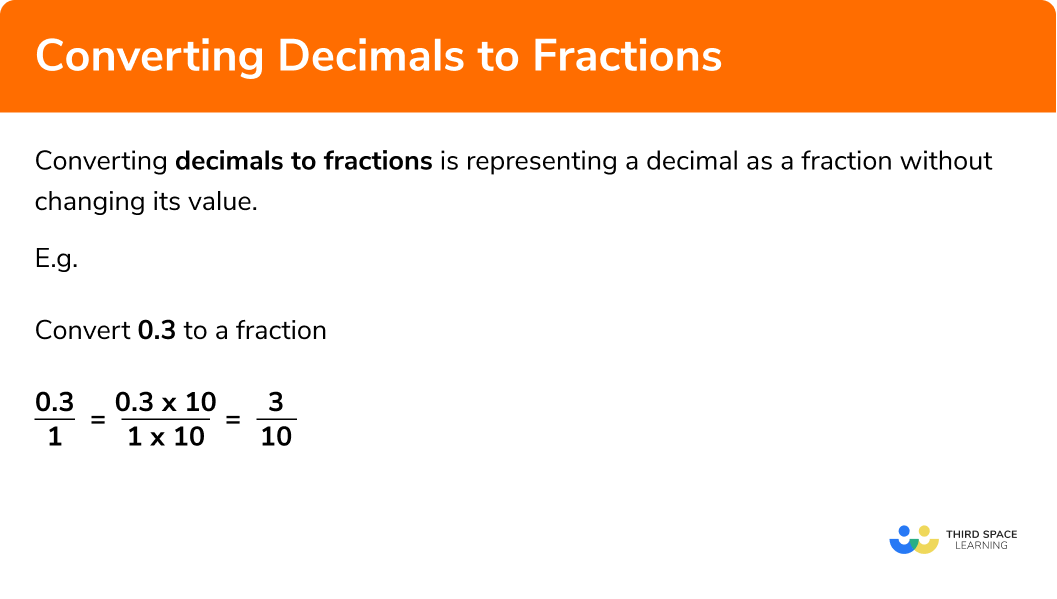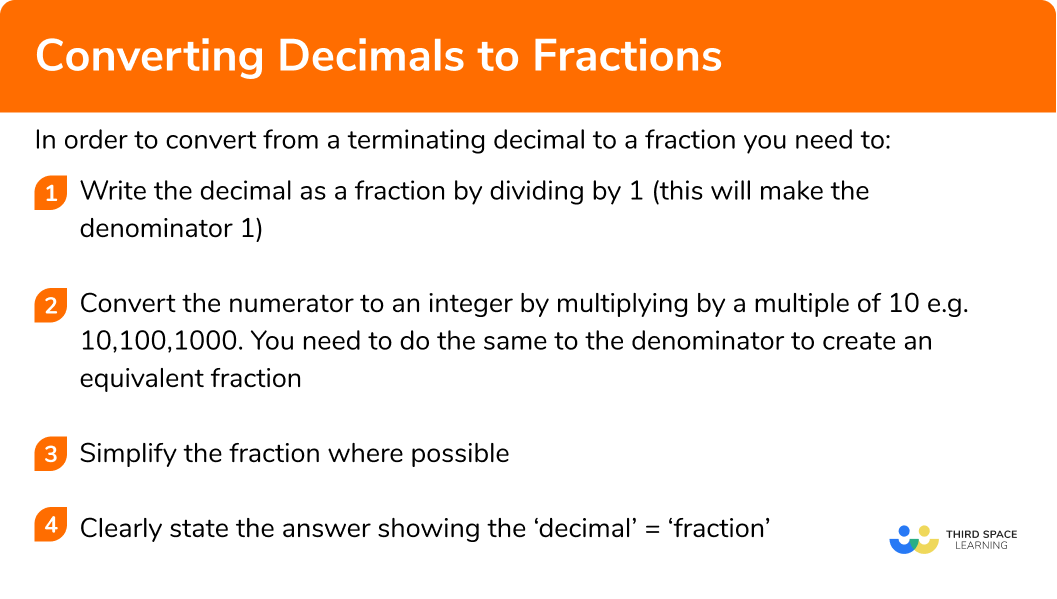GCSE Tutoring Programme
"Our chosen students improved 1.19 of a grade on average - 0.45 more than those who didn't have the tutoring."
In order to access this I need to be confident with:
Place value Decimal places To the power of Simplifying fractionsThis topic is relevant for:

Decimals To Fractions
Here we will learn about converting decimals to fractions.
There are also converting decimals to fractions worksheets based on Edexcel, AQA and OCR exam questions, along with further guidance on where to go next if you’re still stuck.
What is decimals to fractions?
Converting decimals to fractions is representing a decimal as a fraction without changing its value.
E.g.
What is converting decimals to fractions?

Note: The decimals being converted in this page are terminating decimals, which means the decimal stops and does not have an infinite number of decimal places. We can also convert recurring decimals to fractions. Recurring decimals are decimals which have a repeating pattern that continually repeats without stopping.
How to convert from decimals to fractions
In order to convert from a terminating decimal to a fraction you need to:
- Write the decimal as a fraction by dividing by
1 (this will make the denominator1 ) - Convert the numerator to an integer by multiplying by a multiple of
10 , e.g.10, 100, 1000 . You need to do the same to the denominator to create an equivalent fraction - Simplify the fraction where possible
- Clearly state the answer showing the ‘decimal’ = ‘fraction’
Explain how to convert a terminating decimal to a fraction in 3 steps

Decimals to fractions worksheet
Get your free decimals to fractions worksheet of 20+ questions and answers. Includes reasoning and applied questions.
COMING SOONDecimals to fractions worksheet
Get your free decimals to fractions worksheet of 20+ questions and answers. Includes reasoning and applied questions.
COMING SOONConverting decimals to fractions examples
Example 1: converting a simple decimal to a fraction (without simplifying)
Convert
- Write the decimal as a fraction by dividing by
1
2Convert the numerator to an integer (by multiplying by a multiple of
The lowest value in the number
This means if we multiply
If you multiplied the numerator by
3Simplify the fraction if possible
\frac{3}{10} cannot be simplified as
4Clearly state the answer showing the ‘decimal’ = ‘fraction’
Example 2: converting a decimal to a fraction (with simplifying)
Convert
Write the decimal as a fraction by dividing by 1
Convert the numerator to an integer (by multiplying by a multiple of 10). You need to do the same to the denominator to create an equivalent fraction
The lowest value in the number
This means if we multiply
If you only multiplied the numerator by
Simplify the fraction if possible
\frac{22}{100} can be simplified by dividing the numerator and denominator by
Clearly state the answer showing the ‘decimal’ = ‘fraction’
Example 3: converting a decimal to a fraction involving thousandths
Convert
Write the decimal as a fraction by dividing by 1
Convert the numerator to an integer (by multiplying by a multiple of 10). You need to do the same to the denominator to create an equivalent fraction
The lowest value in the number
This means if we multiply
If you only multiplied the numerator by
Simplify the fraction if possible
\frac{385}{1000} can be simplified by dividing the numerator and denominator by
Clearly state the answer showing the ‘decimal’ = ‘fraction’
Example 4: converting a number containing a decimal to a fraction
Convert
Write the decimal as a fraction by dividing by 1
Convert the numerator to an integer (by multiplying by a multiple of 10). You need to do the same to the denominator to create an equivalent fraction
The lowest value in the number
This means if we multiply
If you only multiplied the numerator by
Simplify the fraction if possible
\frac{14}{10} can be simplified by dividing the numerator and denominator by
Clearly state the answer showing the ‘decimal’ = ‘fraction’
Note: This is an improper fraction, we could give this as a mixed number if required.
E.g.
Example 5: converting a number containing a decimal to a fraction
Convert
Write the decimal as a fraction by dividing by 1
Convert the numerator to an integer (by multiplying by a multiple of 10). You need to do the same to the denominator to create an equivalent fraction
The lowest value in the number
This means if we multiply
If you only multiplied the numerator by
Simplify the fraction if possible
\frac{155}{100} can be simplified by dividing the numerator and denominator by
Clearly state the answer showing the ‘decimal’ = ‘fraction’
Example 6: converting a number containing a decimal to a fraction
Convert
Write the decimal as a fraction by dividing by 1
Convert the numerator to an integer (by multiplying by a multiple of 10). You need to do the same to the denominator to create an equivalent fraction
The lowest value in the number
This means if we multiply
If you only multiplied the numerator by
Simplify the fraction if possible
\frac{20006}{10000} can be simplified by dividing the numerator and denominator by
Clearly state the answer showing the ‘decimal’ = ‘fraction’
Common misconceptions
- Multiplying by an incorrect multiple of
10
You must multiply by a multiple of
E.g.
- Simplifying the fraction
The question may say “give your answer in the simplest form”. Always take a moment to see if the fraction can be simplified.
- Not multiplying the denominator by the same as the numerator
When you multiply the numerator by a multiple of
Related lessons
Decimals to fractions is part of our series of lessons to support revision on comparing fractions, decimals and percentages. You may find it helpful to start with the main comparing fractions, decimals and percentages lesson for a summary of what to expect, or use the step by step guides below for further detail on individual topics. Other lessons in this series include:
Practice converting decimals to fractions questions
1. Which is the correct conversion of 0.1 to a fraction in its simplest form?




0.1 written as a fraction is \frac{10}{100} . We can simplify this by dividing both the numerator and denominator by 10 .
2. Which is the correct conversion of 0.4 to a fraction in its simplest form?




0.4 written as a fraction is \frac{40}{100} . We can simplify this by dividing both the numerator and denominator by 20 .
3. Which is the correct conversion of 1.1 to a fraction in its simplest form?




We can convert 1.1 to a fraction by writing it over 1 and multiplying the numerator and denominator by 10 .
4. Which is the correct conversion of 0.006 to a fraction in its simplest form?




0.006 written as a fraction is \frac{6}{1000} . We can simplify this by dividing both the numerator and denominator by 2 .
5. Which is the correct conversion of 30.05 to a fraction in its simplest form?




We can convert 30.05 to a fraction by writing it over 1 and multiplying the numerator and denominator by 100 to give \frac{3005}{1000} . We can simplify this by dividing both the numerator and denominator by 5 .
6. Which of the below is not the fractional equivalent of 0.12 ?




\frac{12}{10} is equivalent to 1.2 not 0.12 .
Converting decimals to fractions GCSE questions
1. Convert each of the following decimals to fractions. All answers must be given in their simplest form
a) 0.7
b) 0.75
c) 0.07
d) 0.007
e) 7.7
(5 marks)
(1)
\frac{3}{4}(1)
\frac{7}{100}(1)
\frac{7}{1000}(1)
\frac{77}{10}(1)
2. Convert each of the following decimals to fractions in their simplest form
a) 0.34
b) 1.12
c) 1.72
(6 marks)
1 mark for any correct fraction given which is not in its simplest form
a) \frac{34}{100}
(1)
OR
\frac{17}{50}(2)
b) \frac{112}{100}
(1)
OR
\frac{28}{25}(2)
c) \frac{172}{100}
(1)
OR
\frac{43}{25}(2)
3. Match each decimal to the correct fraction below
\frac{3}{5}, \frac{1}{4} , \frac{7}{5}, \frac{26}{5}, \frac{1}{100} Q3
a) 0.25
b) 1.4
c) 0.6
d) 0.01
e) 5.2
(5 marks)
(1)
1.4=\frac{7}{5}
(1)
0.6=\frac{3}{5}
(1)
0.01=\frac{1}{100}
(1)
5.2=\frac{26}{5}
(1)
4. Show 0.888 as a fraction in its simplest form
(2 marks)
1 mark for any correct fraction given which is not in its simplest form
\frac{888}{1000}
(1)
\frac{111}{125}(1)
Learning checklist
You have now learned how to:
-
Convert a decimal to a fraction
-
Give a fraction in its simplest form
The next lessons are
Still stuck?
Prepare your KS4 students for maths GCSEs success with Third Space Learning. Weekly online one to one GCSE maths revision lessons delivered by expert maths tutors.

Find out more about our GCSE maths tuition programme.